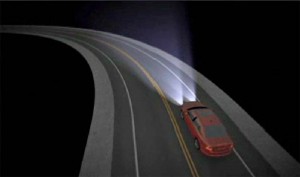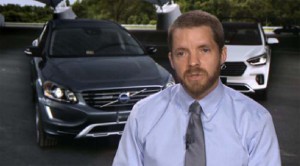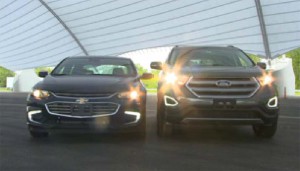The vast majority of midsize SUVs offer headlights that fail to light up the road effectively, according to a newly released study by the Insurance Institute for Highway Safety that found just two vehicles earned a “good” rating and 11 of 37 models tested fell into the “poor category.”
The list of poor performer includes some of the biggest sellers in the segment, such as the Jeep Wrangler, as well as Ford’s Edge and Explorer models. According to the industry trade group, many SUVs do a poor job of lighting the road while others create significant glare for oncoming traffic.
“We continue to see headlights that compromise safety because they only provide a short view down the road at night,” said Matt Brumbelow, a senior research engineer at IIHS.
(Rare bipartisan bill aims to eliminate hot car child deaths. Click Here for the story.)
The new IIHS study found that only two of 37 midsize SUV models delivered “good” lighting: the 2017 Hyundai Santa Fe and the 2017 Volvo XC60. Twelve models earned an “acceptable” rating, 12 more rated “marginal,” and 11 falling into the “poor” category.
By comparison, the low beams on the Kia Sorento, one of the worst-performing models in the test, illuminated the road for just 148 feet, compared to 315 feet for the Volvo XC60. (To put things into perspective: a vehicle going 60 mph down a freeway travels 88 feet per second.)
While many of the models performed poorly because they didn’t provide enough light, others created significant glare that could distract or blind oncoming drivers. More than half of the headlights IIHS tested were faulted for that problem.
Some vehicles offer multiple headlight options, including the Hyundai Santa Fe Sport, a smaller version of the “good” rated Santa Fe. All of the Sport model’s headlights created unacceptable glare, according to the IIHS test, including high-end HID lamps that can “curve” light into a corner as the vehicle turns.
The Ford Edge, one of the weaker performers in the new IIHS lighting test, created significant glare but also failed to provide enough light down the road.
(To see why teens are three times more likely to die in car crashes, Click Here.)
If there was any good new in the new IIHS test, it’s that the midsize models fared slightly better than the smaller SUVs tested last year. At that time, 12 of 21 models were rated “poor,” while only four were deemed “acceptable.”
In the test of midsize SUV models, the models rated “poor” were the: Infiniti QX60, Lincoln MKC, Lincoln MKX, Dodge Journey, Ford Edge, Ford Explorer, GMC Terrain, Hyundai Santa Fe Sport, Jeep Wrangler, Kia Sorento and Toyota 4Runner.
The Insurance Institute has frequently pushed the envelope beyond what federal safety regulations require, often resulting in improvements by vehicle manufacturers. That includes the small overlap test intended to replicate a common highway occurrence where oncoming cars clip each other’s headlights. After the IIHS began releasing crash test results automakers rushed to develop ways to reduce damage and injuries from such crashes.
In the case of its new headlight tests, the IIHS appears to be pushing for change on the part of government regulators, as well as the industry. The National Highway Traffic Safety Administration has so far taken four years to respond to requests by the auto industry to approve for U.S. use so-called adaptive lighting technology available in Europe and Japan that can extend the range of high beams by reducing glare for oncoming drivers.
But IIHS engineer Brumbelow stressed that manufacturers can’t shift blame for all of the problems revealed by the trade group’s new lighting tests.
“Managing glare can be more challenging for taller vehicles like SUVs and pickups because their headlights are mounted higher than on cars,” he said. “Better aim at the factory can minimize glare,” but as there are no federal standards specifically guiding the process, automakers simply weren’t making an effort to reduce this problem.
(Nissan to double number of vehicles with standard Automatic Emergency Braking. Click Here for more.)



